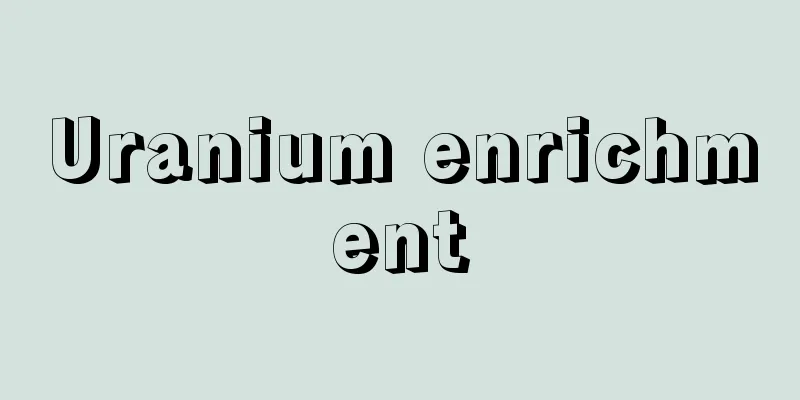Uranium enrichment

|
Uranium-235 is an isotope that is present in only 0.72% of natural uranium, but the process of artificially increasing its abundance is called uranium enrichment, and the result of this process is enriched uranium. Enriched uranium is used as fuel for nuclear power generation and nuclear weapons. During the Manhattan Project (atomic bomb production plan) in World War II, the United States tried all the methods of isotope separation known at the time. This was because it was expected that if they could separate and enrich uranium-235, a fissile nuclide, they could easily create a high-performance bomb. shows the relationship between the enrichment level of uranium-235 and the minimum mass (critical mass) required to cause a nuclear explosion, and it can be seen that enrichment levels of 30% or less cannot actually be used to make a nuclear bomb. For this reason, when exporting enriched uranium for peaceful purposes, the enrichment level is usually limited to 20% or less for the purpose of nuclear non-proliferation. [Atsunosuke Nakajima and Jun Tateno September 15, 2015] Method of manufacturing enriched uranium (uranium enrichment method)Various uranium enrichment methods (uranium enrichment technologies) will be discussed later, but historically the most important is the "gaseous diffusion method." As mentioned above, the United States built three huge enrichment plants based on the gaseous diffusion method during and immediately after World War II, at a huge cost of $2.3 billion, as part of the Manhattan Project. The combined capacity of these plants reached 17,200 ton separation work units, and until around 1970 they accounted for 95% of the total production in the capitalist world. This is the reason why light water reactors came to dominate the world's nuclear reactor market in nuclear power generation, which also uses nuclear fission. The Soviet Union (now Russia), the United Kingdom, China, and France also built and operated gaseous diffusion plants, but these countries are now switching to the "centrifuge method" ( ). The "centrifuge method" is also used in Japan. Japan Nuclear Fuel Limited has been operating a commercial plant in Rokkasho Village, Aomori Prefecture since 1992, based on the technological achievements of uranium enrichment using the centrifugal separation method, which was developed by the Ningyo-toge Plant of the Power Reactor and Nuclear Fuel Development Corporation (later the Nuclear Fuel Cycle Development Institute, currently the Ningyo-toge Environmental Technology Center of the Japan Atomic Energy Agency). This method makes it possible to produce highly enriched uranium in a relatively small factory, and is therefore called a "sensitive technology" that is directly linked to nuclear proliferation. Other methods still in the research and development stage include the "laser method" and the "chemical exchange method." Of these, the "chemical exchange method" was successfully demonstrated at a pilot plant in Asahi Kasei's Hyuga factory, the first in the world, but research into this method has now been discontinued and it has not yet been put to practical use. [Atsunosuke Nakajima and Jun Tateno September 15, 2015] Comparison of various uranium enrichment methodsThe main uranium enrichment methods currently in use or under research and development are listed below. (1) Gaseous diffusion method: This method uses uranium hexafluoride ( UF6 gas) as the gaseous compound, and utilizes the difference in the diffusion speed of molecules. When gas is diffused through a special membrane, isotopes are separated in proportion to the square root of the ratio of the masses of the gas molecules. This method is suitable for large-volume processing because it has few moving parts, has a simple structure, and is easy to expand capacity, but has drawbacks such as a small separation coefficient per cascade (a collection of diffusion tubes) and high power consumption. It is currently in practical use. (2) Centrifugal separation method When a vertical cylinder is rotated at high speed using UF6 gas, centrifugal force is generated, which makes it easy for uranium-238, which has a larger mass number, to gather on the outside, while uranium-235 tends to gather on the inside. Compared to the gas diffusion method, the separation factor is much greater, and the power consumption is about one-tenth of that. It is small in scale and economical, but the mechanism is complex and requires advanced industrial technology. The key to the success of this method is how to mass-produce long-bodied, high-performance centrifuges with high peripheral speeds at low cost. Titanium-based alloys are used as a lightweight and strong material, and the key to the technology lies in the development of "bearings" that enable high-speed rotation. This method is currently in practical use. (3) Chemical exchange method: Uses the exchange reaction between tetravalent uranium and hexavalent uranium. Multiplexed with ion exchange resin. Advantages include fewer moving parts, making it possible to miniaturize plants and reduce energy consumption. However, it takes a long time to reach steady state. Research and development is being conducted in Japan and France, with Japan having been successful. (4) Atomic laser method Metallic uranium is vaporized, and only uranium 235 is separated by ionizing it with laser light, utilizing the isotope shift of the spectrum. The separation factor is extremely large, and there is a possibility of greatly reducing construction costs. However, it is necessary to develop a high-power laser, and it is difficult to handle uranium metal at high temperatures. (5) Molecular laser method: This method irradiates laser light onto UF6 gas cooled by a supersonic nozzle, converting only uranium 235 into powdered UF5 gas and collecting it. This method has a large separation factor and has the potential to significantly reduce construction costs. However, this method requires the development of a high-repetition laser. [Atsunosuke Nakajima and Jun Tateno September 15, 2015] [References] | | | [Additional information] |The diagram shows the relationship between the enrichment of uranium -235 and the critical mass required for a nuclear explosion . Relationship between uranium enrichment and critical mass (Figure A) ©Shogakukan "> Uranium enrichment by centrifugation (Figure B) Source: Shogakukan Encyclopedia Nipponica About Encyclopedia Nipponica Information | Legend |
|
ウラン235は天然ウラン中にわずか0.72%しか含まれていない同位体であるが、その存在比を人工的に大きくする操作がウラン濃縮uranium enrichmentで、その操作の結果得られるものが濃縮ウランである。濃縮ウランは、原子力発電や核兵器の燃料として用いられる。 第二次世界大戦中のマンハッタン計画(原爆製造計画)でアメリカは、当時知られていたあらゆる同位体の分離法を試みた。それは、核分裂性核種であるウラン235を分離濃縮できさえすれば、容易に高性能の爆弾をつくれる見通しがあったからである。は、ウラン235の濃縮度と核爆発をおこすのに必要な最小限の質量(臨界質量)との関係を示すもので、これから濃縮度30%以下では実際上、核爆弾材料にはできないことがわかる。平和利用を目的とした濃縮ウランの輸出に際して、核不拡散を目的として濃縮度が通常20%以下に制限されるのはこの理由による。 [中島篤之助・舘野 淳 2015年9月15日] 濃縮ウランの製造方法(ウラン濃縮法)各種のウラン濃縮法(ウラン濃縮技術)については、それぞれ後述するが、歴史的にもっとも重要であったのは「ガス拡散法」である。先にも述べたマンハッタン計画により、アメリカは第二次世界大戦中およびその直後にガス拡散法に基づく三つの巨大な濃縮工場を、23億ドルの巨費を投じて建設した。その能力合計は1万7200トン分離作業単位に達し、1970年ごろまでは資本主義圏全生産量の95%を占めていた。このことが、同じ核分裂を利用する原子力発電において軽水炉が世界の原子炉市場を制覇するに至った理由である。ソ連(現、ロシア)、イギリス、中国、フランスもガス拡散法の工場を建設、運転していたが、これらの国々は「遠心分離法」に転換しつつある()。なお「遠心分離法」は、日本でも行われている。日本原燃(株)は、かつて動力炉・核燃料開発事業団(動燃)の人形峠事業所(のちの核燃料サイクル開発機構、現在の日本原子力研究開発機構・人形峠環境技術センター)が研究開発した遠心分離法によるウラン濃縮の技術成果を基にして、1992年(平成4)より青森県六ヶ所村で商業用プラントの操業を行っている。この方法は比較的小規模な工場で高濃縮ウランをつくることができるので、核拡散に直結した「センシティブ(機微)な技術」とよばれる。 そのほかに研究開発段階のもので「レーザー法」「化学交換法」などがある。このうち「化学交換法」は旭化成(株)の日向(ひゅうが)工場のパイロット・プラントで、世界に先駆けて成功したが、現在は研究が中止されており、実用化はされていない。 [中島篤之助・舘野 淳 2015年9月15日] 各種のウラン濃縮法の比較現在、実用および研究開発中のおもなウラン濃縮法を以下に示す。 (1)ガス拡散法 気体状化合物としては六フッ化ウラン(UF6ガス)を用い、分子の拡散速度の差を利用する濃縮法。特殊な隔膜を通して気体を拡散させると、気体分子の質量の比の平方根に比例して同位体の分離が行われることを利用する。設備に可動部が少ないため、構造が単純で容量の拡大が容易なことから、大容量の処理に適しているが、カスケード(拡散筒の集合体)1段当りの分離係数が小さく、電力消費量が大きいなどの難点がある。現在実用化されている。 (2)遠心分離法 UF6ガスを用い、縦形円筒を高速で回転させると、遠心力の作用で、質量数の大きいウラン238は外側に、ウラン235は内側に集まりやすいことを利用する。ガス拡散法に比べて分離係数はずっと大きく、電力消費量も10分の1程度になる。規模も小さく経済性に優れているが、機構的に複雑で高度な産業技術が必要とされる。周速の大きい長胴型の高性能遠心機をいかに安価で量産するかが、この方法の成功の鍵(かぎ)である。軽量で強靭(きょうじん)な材料としてチタン系合金が用いられるが、高速回転を可能にする「軸受」の開発が技術の鍵をにぎっている。現在実用化されている。 (3)化学交換法 4価ウランと6価ウランの交換反応を利用する。イオン交換樹脂で多重化。利点としては、可動部が少なく、プラントの小型化、エネルギー消費量の低減化が可能である。しかし、定常達成時間が長い。日本、フランスで研究開発が進められ、日本は成功している。 (4)原子レーザー法 金属ウランを蒸気化し、スペクトルの同位体シフトを利用してウラン235のみをレーザー光でイオン化して分離する。分離係数がきわめて大きく、建設費大幅低減の可能性がある。しかし、大出力レーザーの開発が必要で、ウラン金属の高温での取り扱いが困難である。 (5)分子レーザー法 超音速ノズルで冷却されたUF6ガスにレーザー光を照射し、ウラン235のみを紛体のUF5ガスにして捕集する方法。分離係数が大きく、建設費大幅低減の可能性がある。ただし、高繰り返しレーザーの開発が必要。 [中島篤之助・舘野 淳 2015年9月15日] [参照項目] | | | [補完資料] |図は、ウラン235の濃縮度と核爆発に必要な臨界質量との関係を表す©Shogakukan"> ウラン濃縮度と臨界質量との関係〔図A〕 ©Shogakukan"> 遠心分離法によるウラン濃縮〔図B〕 出典 小学館 日本大百科全書(ニッポニカ)日本大百科全書(ニッポニカ)について 情報 | 凡例 |
<<: Ulaanbaatar - Ulaanbaatar (English spelling)
>>: Uranium-lead method - uranium-lead method
Recommend
Brantôme, Pierre de Bourdeille, abbé de
Born: Around 1540. Périgord, Bourdeilles [Died] Ju...
Ashino
A district of Nasu Town, Nasu County, Tochigi Pre...
Selected insects - Erabimushi
…It is also called Mushi Erami, Senmushi, Mushi E...
Spotted knifejaw
A marine fish belonging to the order Perciformes ...
Prince Katsuragi - Prince of Kazuraki
?-? A prince of Emperor Kinmei in the 6th century...
Changsha Kiln
A kiln located in Tongguan Town, Wangcheng County,...
Gyougetsubou
[Born] Bun'ei 2 (1265) [Died] November 8, 1328...
Puffball - Dust Mushroom
A basidiomycete mushroom of the Pungentromediales...
Oonie Festival
…It is also called the Oonie Festival, the Senso ...
Kazimierz Jagiellonczyk - Kazimierz Jagiellonczyk
…The personal union of Poland and Lithuania quick...
Rectangular roof - Kaneoriyane
...Most commonly used variations include butterfl...
Recamier (English spelling)
...In this period, there were still salons held b...
Fault topography
The various landforms formed by faults can be bro...
Hayashi Senjuro
Army officer and politician. Born on February 23,...
Yarobi farming method - Yarobi nouhou
This is a term for agricultural techniques that s...









